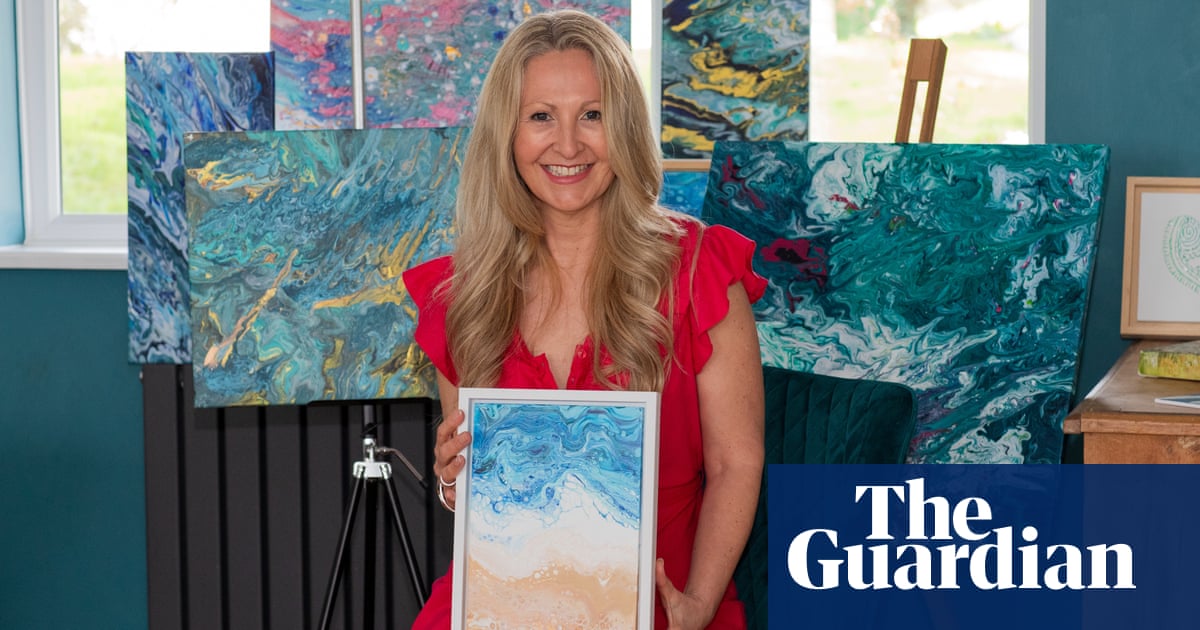I’ve always enjoyed painting and drawing. I planned to become an artist, but when I was offered a job as a stockbroker at 19, the pull of a glamorous lifestyle and the earning potential compared with that of an impoverished artist was too strong. But, during my 15-year career, I kept up art as a hobby, dabbling in pottery and jewellery-making as well as painting.
In 2008, I took a break from work and ended up living in Hawaii for seven years. Inspired by the landscape, I took some art courses, which reignited my energy and excitement for it.
When my parents died unexpectedly in quick succession in 2019 and 2021, I threw myself into my artwork. I found it helped me cope with the loss.
Using acrylic paint on canvas, I created abstract pieces and shared my work on Instagram. In 2023, a follower messaged me, saying she loved what I was doing and wanted to commission me – but she had an unusual request. She wanted me to paint a picture using her mother’s ashes.
My thoughts immediately turned to my own mum, Carol. Her ashes were in an urn in my cupboard. I felt they ought to be scattered, but I didn’t want to be separated from her.
My mum was joyful and had been an artist herself. The idea of using ashes in my artwork resonated with me, and I thought Mum would have liked it, too – being part of a beautiful painting, looked at and appreciated every day.
I have an inquiring, scientific mind, so I wanted to make sure everything was done properly and respectfully. Cremated remains have a high pH level, similar to bleach. I was concerned about how that would affect the paint. Would the ashes fade or even erode it?
I contacted a forensic laboratory, which helped me develop a stabilising agent, so ashes could be added to my paint safely. I had to believe in the technique – if I wasn’t prepared to use my own mum’s ashes, I shouldn’t be using someone else’s.
I painted a seascape using acrylic paint mixed with Mum’s ashes and the stabilising agent. It was an emotional experience, and I was really pleased with the finished piece. It takes pride of place in my kitchen, where I spend most of my time, and it feels like Mum is with me.
That gave me the confidence to accept my client’s commission to paint a seascape using her mother’s ashes. It was incredibly nerve-racking. I feel things very deeply; there was added emotion and pressure. I worried she might not like the finished piece. But she loved it. It was a beautifully moving moment when I handed it over – there were tears, but happy ones.
I have now painted about 20 memorial pieces using ashes, and I’ve created my ownwebsite, ash2art.com. People are often curious about my techniques. I send clients a plastic wallet and pouch so they can give me a small amount of their loved one’s ashes. The remains come in different sizes and textures and require some preparation so they are fine enough to add to the paint.
Other pieces I’ve painted include a pair of flower meadows for a brother and sister to celebrate their mum, who was a keen gardener. They wanted something joyful and colourful to remember her by. Last year, someone asked if I would paint a portrait of their late cat, Mindy, incorporating her ashes. I’m an abstract painter, and pet portraiture was out of my comfort zone, but I really wanted to do it.
Sign up toInside Saturday
The only way to get a look behind the scenes of the Saturday magazine. Sign up to get the inside story from our top writers as well as all the must-read articles and columns, delivered to your inbox every weekend.
after newsletter promotion
I used a photograph as the foundation of the painting, and Mindy’s owner loved it. Pet cremation is a growing trend, and since then I’ve painted several other memorial pictures of cats and dogs.
I thought using cremated remains in my work would open me up to criticism, but I’ve been overwhelmed by the comments of love and support. People find my memorial pieces comforting. There’s a reassurance in having their loved one’s or their pet’s ashes nearby, immortalised in an original painting.
I never imagined I’d be painting using ashes, but it’s a beautiful way to honour the memory of our loved ones.
As told to Kate Chapman
Do you have an experience to share? Emailexperience@theguardian.com
